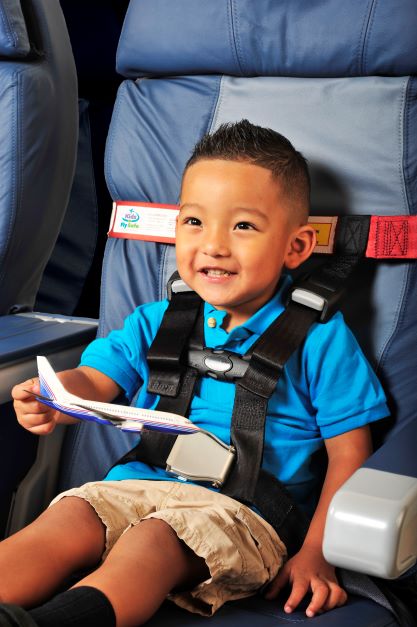
The safest place for your child under the age of two on a U.S. airplane is in approved child restraint system (CRS) or device, not in your lap. Your arms aren't capable of holding your in-lap child securely, especially during unexpected turbulence. ‘Unrestrained lap children are prone to in-flight injuries, particularly during meal service or turbulence,’ according to a 2019 study by the National Institutes of Health.
The FAA strongly urges you to secure your child in an approved CRS or other approved device for the entirety of your flight. Buying a ticket for your child is the only way to guarantee that you will be able to use a CRS. It's the smart and right thing to do so that everyone in your family arrives safely at your destination. Buckle up for the car ride to the airport and once you arrive at your destination.
A child restraint system (CRS) is a forward- or rear-facing hard-backed child safety seat. For motor vehicles, car seats are self-certified by the car seat manufacturer to meet federal safety standards, including strict crash performance standards. The National Highway Traffic Safety Administration rates car seats based on ease-of-use so you can make an informed decision about the right seat for your child.
A CRS must be certified for use in aircraft. Confirm your child’s seat has “This restraint is certified for use in motor vehicles and aircraft” printed on it or it is approved by a foreign government and bears the required label or marking.
Read the user’s manual to confirm that your CRS can be secured properly in an airplane seat. Otherwise, you may be asked to check the CRS as baggage.
A CRS must be installed in a aircraft seat, according to manufacturer's instructions. This includes placing the CRS in the appropriate forward- or aft-facing direction as indicated on the device label for the size of the child.
The FAA prohibits passengers from using booster seats or backless CRS during ground movement, take-off and landing.

AmSafe’s Child Aviation Restraint System (CARES) device is FAA-certified for children who are up to 40 inches tall and who weigh between 22 and 44 pounds. The device provides for those who are capable of sitting upright alone in a forward-facing position and who occupy their own seat. This supplemental restraint is used with the existing aircraft seatbelt for improved child safety. CARES is lightweight and adjusts to fit virtually all economy-, business-, and first-class airline seats. This type of device provides an alternative to using a hard-backed CRS. CARES is approved for use during all phases of flight—movement on the surface (taxi), take-off, landing, and turbulence, and is approved only for use on aircraft, but not for use in motor vehicles. If you're using a CARES device, make sure it has "FAA Approved in Accordance with 14 CFR 21.8(d), Approved for Aircraft Use Only" or "FAA Approved in Accordance with 14 CFR 21.305(d), Amd 21.50 6-9-1980, Approved for Aircraft Use Only" on it.
OR
Beware of CARES counterfeits sold online. Buy direct from the manufacturer to be sure the CARES device you use is authentic and manufactured with the same industrial-strength webbing as aircraft seat belts. The FAA is aware of disreputable third-party retailers who offer reproduction devices that resemble CARES for sale but that have not been engineered to the highest aviation-safety standards by AmSafe®. Learn more about CARES.
If your approved CRS, for which a ticket has been purchased, does not fit in a particular seat on the aircraft, the airline is responsible for accommodating the CRS in another seat in the same class of service. The airline may have policies that dictate the specific safe seat locations for specific aircraft.
Although children who have not reached their second birthday are permitted to travel as lap children, the FAA strongly discourages this practice and recommends that you secure your child in an approved CRS in their own seat for the entire flight. While there is no regulatory prohibition from using a booster seat or harness vest (or other non-approved devices) for a lap child during the cruise portion of the flight only, airlines have policies which may or may not allow the use of those devices. Check with your airline.
Most young children who use a CRS weigh 40 lbs. or less. However, there are some children with physical challenges who weigh more than 40 lbs. and need the support and security of a CRS or device so they can travel safely on an airplane.
Airlines must allow a child who is under the age of 18 to use an approved CRS that is properly labeled, appropriate for the child's weight, and as long as the child is properly secured in the CRS. Many companies manufacture CRSs approved for use on aircraft that are specifically designed for larger children who are physically challenged.
Adults (18 years or older) who have physical challenges that require the support and security of a CRS or device in order to travel safely on an airplane may request an exemption to the FAA's regulations that require each passenger to be properly secured by a safety belt. This request may also be made by an airline on the passenger's behalf. Several companies manufacture restraint systems for adults with physical challenges.
To review previously granted exemptions on special needs travel, go to the FAA Automated Exemption System and type "7831", "8264" or "9834" in the "Exemption Number" search field and hit "enter" or click on "Search" on the left side of the screen. Highlight the document you wish to view and click on "View Document" on the left side of the screen.